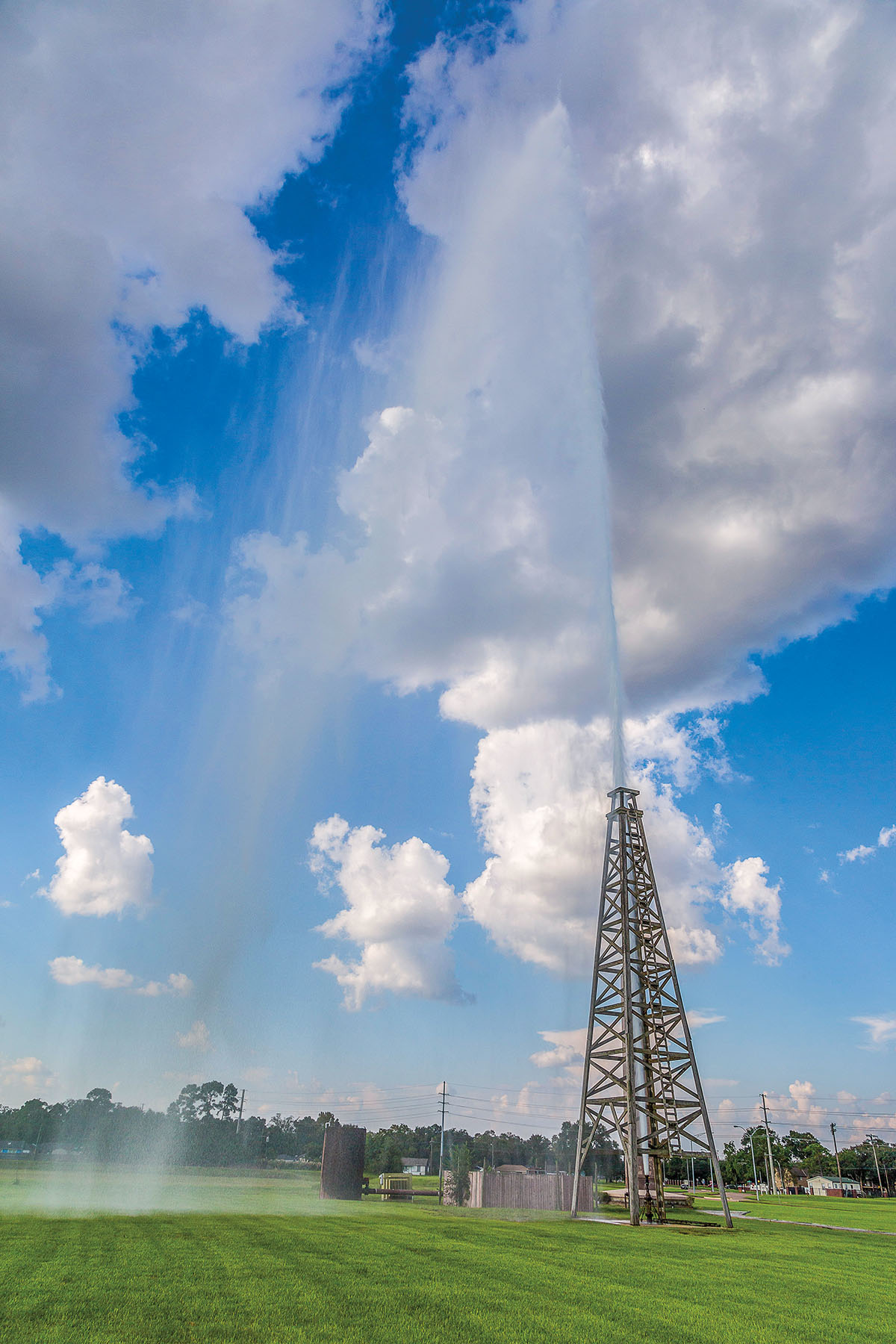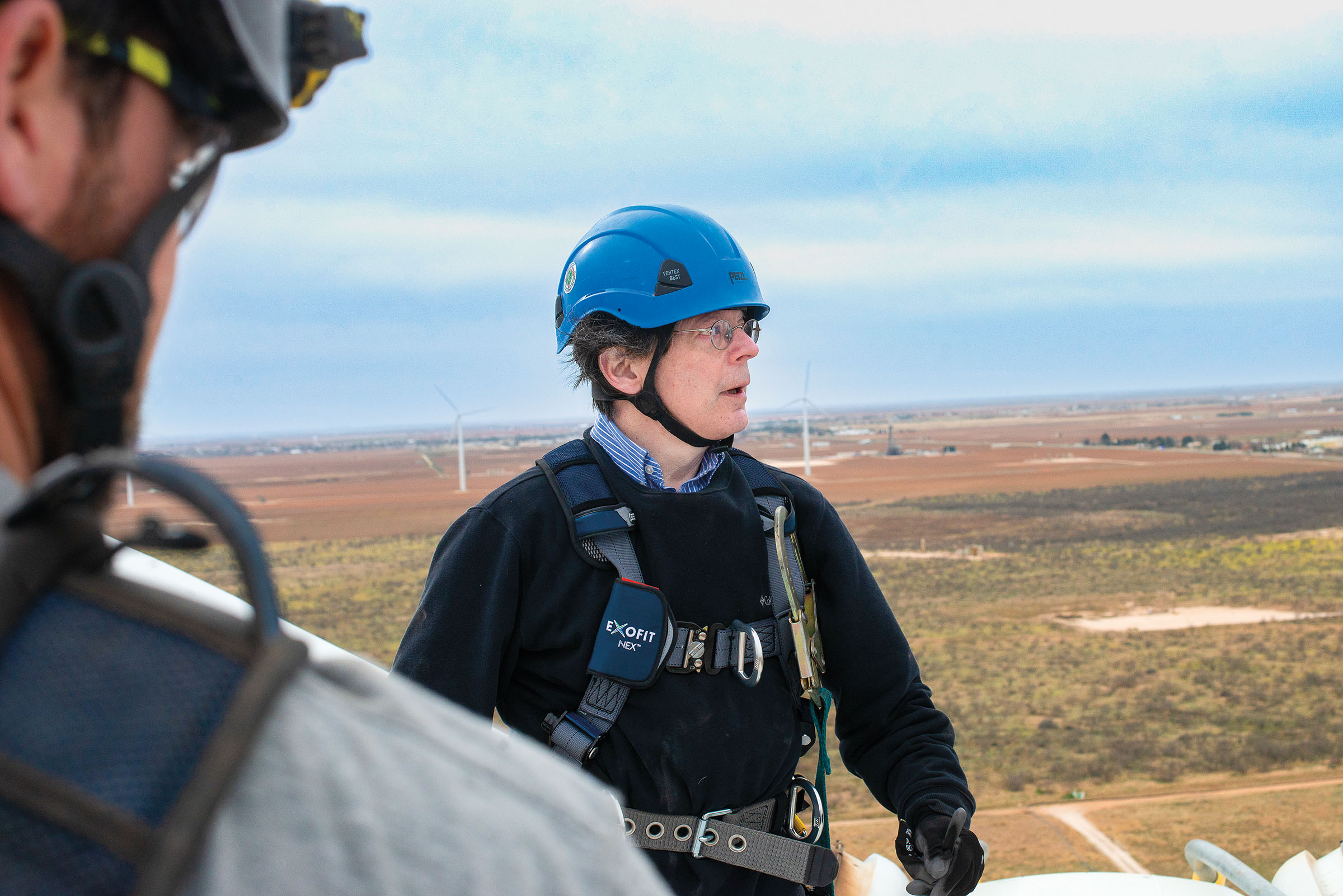
The geyser at the Spindletop Gladys City Boomtown Museum recreates the historic discovery.
My muscles shake as I climb up the inside of a seemingly endless vertical tunnel, stopping at platforms along the way to catch my breath. Alongside a handful of companions from Invenergy and a photographer, I make my way up a 300-foot wind turbine near the West Texas town of Stanton. On this 2019 trip, we’re led by Jake Thompson, manager of the clean energy company’s wind farm.
At the top, I climb out, tether myself to rails on the surface, and gaze at the magnificent, spare landscape of the Permian Basin. Lines of lazily spinning wind turbines stretch out toward the horizon, but I see familiar pumpjacks, too, and in the distance, flaring natural gas at the top of pipes dancing brightly. And while I can’t see them from here, utility-scale solar farms aren’t too far away—all of these together evoking a vision of the past, present, and future.
The story of Texas energy began with a blast and a big mess. It was Jan. 10, 1901, about 10:30 a.m., and outside of Beaumont the ground around a wildcat well began rumbling ominously. Tons of mud and rocks suddenly rocketed high into the air, and then a breathtaking geyser of oil rose more than 100 feet, coating the dirt and settling into pools all around. The force of the oil blew the crown block off the derrick and launched unearthed pipe skyward. It took nine days for the drillers to devise a way to cap the Lucas Gusher, which was spewing around 100,000 barrels of oil each day. A crazed boomtown was born, as tens of thousands of would-be oilmen and deal-makers streamed into Beaumont.
This wasn’t the first U.S. oil strike, or even the first in Texas. But the find at Spindletop Hill “announced this new era—that Texas is here,” says Michael Webber, a University of Texas professor, clean technology investor, and author of Power Trip: The Story of Energy. It set Texas on a path to be a giant in adopting each wave of energy innovation over the ensuing decades.
“We never claimed to be the first,” says Judith Walker Linsley, coauthor of a beguiling history of Spindletop, Giant Under the Hill. “We were the ones who showed there was enough oil down here to power the world.” As the world shifts to alternative forms of energy to power the grid and innovations like electric vehicles, Texas has taken the lead in the production of renewables, opening up opportunities for a more sustainable future.
Before Spindletop, Beaumont’s economy depended largely on lumber, supplemented by agriculture and cattle. Soon the land was steepled with derricks; America’s premier oil companies, including the giants that came to be known as Gulf Oil, Texaco, and Exxon, can trace part of their origins to that coastal plain. Industries grew up around storing the region’s oil, transporting it, and refining it.
Beaumont puts this history proudly on display at the Spindletop Gladys City Boomtown Museum, on the campus of Lamar University, which I visit on a rainy September day. The museum recreates Gladys City—one of the communities caught up in the boom—and the original derrick. You can experience the gusher as the well shoots 3,000 gallons of water 100 feet into the air.

The author stands atop a wind turbine near Stanton in 2019 on a reporting trip for The New York Times.
Finding a profitable use for all that oil was not a sure thing. Gasoline, at the time, “was an unwanted byproduct of kerosene,” Linsley explains, but the newfound quantity led companies to find a use for it. With the development of combustion engines that burned gasoline, and businesses tweaking coal-burning furnaces to burn liquid fuels, markets opened up.
“History,” Linsley tells me, “is so much dependent on timing.”
Oil exploration spread across the state, with wells pincushioning fields that geologists found across Texas’ vast expanse and out into the Gulf of Mexico. Oil was its own economic engine, global economy, and form of power for whoever controlled it, whether oil nations like Russia or oil states. Regulators, in the form of the Texas Railroad Commission, set the production quotas that set prices until the 1970s, making it “the most powerful government agency in the world,” Webber says.
Boomtown
Author Stephen Harrigan’s comprehensive Texas history Big Wonderful Thing has vivid passages on Spindletop. But while writing the book, Harrigan had trouble finding the exact site of the first well. “When you think about the great Texas historical places, like the Alamo or Dealey Plaza or Mission Control in Houston, they’re pretty easy to find,” he says. “But Spindletop is distinguished by how indistinguishable it is.”
Instead of trekking on foot and across train tracks to see the original site, try the Spindletop Gladys City Boomtown Museum, which features a replica boomtown from the era as well as a reenactment of the Spindletop gusher.
5550 Jimmy Simmons Blvd.,
Beaumont.
Open Tue-Sat 10 a.m.-5 p.m.,
Sun 1-5 p.m.
409-880-1750;
lamar.edu/spindletop-gladys-city
Texas oil wealth seeped into popular culture, as well, as Hollywood created stereotypes of the eccentric oilman—extravagant spenders with big, combative personalities depicted in characters like James Dean’s reckless Jett Rink in Giant (1956) and James Garner’s wily Henry Tyroon in The Wheeler-Dealers (1963).
Continued innovation brought more and more oil and gas out of the ground. The advent of hydraulic fracturing, or fracking, in the 1940s and new horizontal drilling techniques forced enormous amounts of oil and gas from geological formations that had produced poorly with conventional drilling.
Today, Texas produces more oil and gas than any other state, according to the U.S. Energy Information Administration, with 42% of the nation’s crude oil production and a third of the nation’s refining capacity.
But times change, and sources of energy shift, too. The Lone Star State is now the highest renewable energy producer in the nation; in 2022, Texas produced 136,118 gigawatt-hours from solar and wind to California’s 52,927. “We’re not the first mover, but when we move, we move at tremendous scale,” Webber says. Now Texas generates 26% of all wind energy in the nation, according to the EIA, and solar power is making a significant and growing contribution to the grid. The state is even enjoying a boom in energy storage systems, which, according to the Texas Tribune, are thought to have prevented blackouts in the grid’s most wobbly moments last summer.
The renewables boom, Webber says, is the key to understanding Texas’ complicated relationship with climate change. The state is “uniquely exposed to the risks” of a warming planet, he notes, with episodes of heat, drought, destructive storms, and flooding—which makes Texas a victim. But its world-shifting oil and gas production has contributed mightily to the problem, also making the state a villain, he says. “[But Texas is also] a victor, because of the huge push we’re making into the kinds of energy solutions that can help solve the problem,” he concludes. “We play all three roles.”
Today’s renewables point the way to an energy future for Texas rich in innovation. In North Texas, a new plant is under construction that will produce hydrogen from water using wind power, promising a fuel without greenhouse gas emissions. In Ector County, not far from where I stood atop that wind turbine several years ago, energy giant Occidental and financial powerhouse BlackRock are building STRATOS. It will be the world’s largest plant to draw down carbon dioxide from the air—a way to start reducing the climate damage caused by fossil fuel emissions.
New technologies can be iffy things; some projects go bust, and some never become economically feasible. Getting it right may take the gumption of wildcatters. If that’s the case, then the state that gave us Spindletop might just lead the way.








